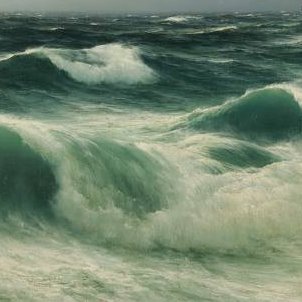Oswald Achenbach, Fishermen
The two light sources in this 19th century work are the moon and a torch held by one of the fishermen. The warm light of the torch helps bring the foreground of the scene forward, while the cool, silver lunar light, filtered through the smoke of a smouldering volcano (Vesuvius perhaps), makes the background recede.
The artist has chosen to conceal both these light sources, imbuing the painting with an engaging sense of mystery; a quality that seems to have been aimed for in the 19th century but is often neglected in these days of sound bites and instant information.
The equilibrium of a square format helps create a mood of tranquility.
Achenbach (2 February 1827 – 1 February 1905) was a German landscape painter. Born in Düsseldorf, he received his art education from his brother, Andreas Achenbach. His landscapes generally dwell on the rich and glowing effects of color which drew him to the Bay of Naples and the neighborhood of Rome.

